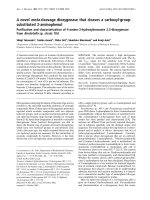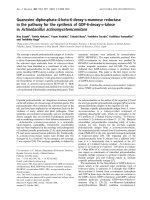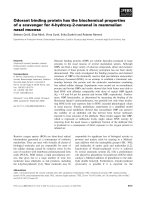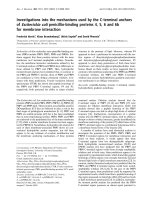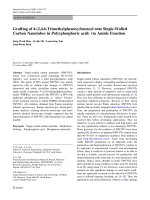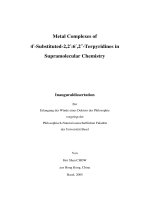Metal Complexes of 4′-Substituted-2,2′:6′,2″-Terpyridines in Supramolecular Chemistry
Bạn đang xem bản rút gọn của tài liệu. Xem và tải ngay bản đầy đủ của tài liệu tại đây (11.95 MB, 341 trang )
Metal Complexes of
4′-Substituted-2,2′:6′,2″-Terpyridines in
Supramolecular Chemistry
Inauguraldissertation
Zur
Erlangung der Würde eines Doktors der Philosophie
vorgelegt der
Philosophisch-Naturwissenschaftlichen Fakultät
der Universität Basel
Von
Hoi Shan CHOW
aus Hong Kong, China
Basel, 2005
Genehmigt von der Philosophisch-Naturwissenschaftlichen Fakultät der auf Antrag
von:
Prof. Dr. E. C. Constable Prof. Dr. A. Pfaltz
Basel, den 25 Januar 2005
Prof. Dr. H J. Wirz
Dekan
To
My Dear Parents
&
Wing Yin
Summary
i
Summary
This thesis presents 4′-substituted-2,2′:6′,2″-terpyridine ligands and their complexes
within the perspective for supramolecular chemistry.
Chapter 1 gives a brief introduction to supramolecular chemistry,
metallosupramolecular chemistry, 2,2′:6′,2″-terpyridine complexes and dynamic
combinatorial libraries.
Chapter 2 discusses the synthesis and characterisation of ligands L
1
-L
9
containing
one 2,2′:6′,2″-terpyridine metal-binding domain. These ligands contain different
substituents at the 4′-position of the 2,2′:6′,2″-terpyridine which differ from one
another in the length of the chains, in the linkages of the chains or in the terminal
domains.
Chapter 3 describes the synthesis and characterisation of the mononuclear iron(II)
and ruthenium(II) complexes formed with L
1
-L
9
.
Chapter 4 describes the synthesis and characterisation of the mononuclear cobalt(II)
complexes formed with L
1
-L
9
. A newly established method for the NMR
spectroscopic assignment of Co(II) complexes, and some preliminary studies of
combinatorial libraries by mixing two Co(II) complexes, are also discussed.
Chapter 5 discusses the synthesis and characterisation of ligands L
10
-L
17
, which
contain two 2,2′:6′,2″-terpyridine metal-binding domains. These two 2,2′:6′,2″-
terpyridine metal-binding domains are linked by different naphthalene
bis(ethyleneoxy) spacers at their 4′-positions.
Chapter 6 discusses the synthesis and characterisation of dinuclear ruthenium(II)
complexes formed by ligands L
11
-L
14
, L
16
-L
17
.
Chapter 7 describes the synthesis and characterisation of [n+n] ruthenium(II) and
iron(II) metallomacrocycles which formed by cyclisation reactions involving ligands
L
11
-L
17
.
Acknowledgements
ii
Acknowledgements
Many thanks to my supervisors: Prof. Edwin Constable, for his great patience, unique
thinking, and tolerance of helping me to solve every problem; Prof. Catherine
Housecroft, for her help, support, and encouragement during the past three years.
Grateful acknowledgement is due to my scientific collaborators in both the University
of Birmingham and the University of Basel. Thanks to all the support staff in the
Chemistry Department in Birmingham for help when I started my research work, and
the scientific staff in Department of Chemistry in Basel for their hard work and
support to allow me to finish my study. Special gratitude to Dr. K. Kulicke for his
ideas and help; and to Markus Neuburger and Dr. Silvia Schaffner for their kind help
in solving the crystal structures. Also, thanks to Professor J. Lacour and Dr. R. Frantz
at the University of Geneva for studying the stereochemical properties of the chiral
complex [{Fe(L
14
)}][PF
6
]
2
with chiral reagents.
The ECC/CEH group in both Birmingham and Basel has given great support for my
research work. Thanks for the help and friendship from all my colleagues: Tao, Pan,
Valerie J, Ayten, Robyn, Azad, Chris, Annette, Amar, Barbara, Deborah, Sebastien,
Egbert, Lukas, Ljumni, Ellie, Valerie C, Conor, Hein, William, Dan, Michael and
Jonathon.
Financial support is gratefully acknowledged from the University of Birmingham, the
Schweizer Nationalfonds zur Förderung der wissenschaftlichen Forschung and the
University of Basel.
Thanks to Beatrice Erismann and Markus Hauri for their help, especially when I
started in Basel, and my family and my friends for their love, care and unconditional
support.
Contents
iii
Contents
Summary i
Acknowledgements ii
Contents iii
Abbreviations vi
General experimental ix
Compound labelling scheme x
Chapter 1: Introduction
1
1.1 Supramolecular chemistry 1
1.2 Metallosupramolecular chemistry 3
1.3
2,2′:6′,2″-Terpyridine complexes
10
1.4 Dynamic combinatorial libraries 19
1.5 Aims 22
1.6 References 23
Chapter 2:
Synthesis of 4′-Substituted-2,2′:6′,2″-Terpyridine
Ligands
31
2.1 Synthesis 33
2.2
1
H NMR spectroscopic characterisation 36
2.3
13
C NMR spectroscopic characterisation 46
2.4 Mass spectrometric characterisation 49
2.5 Crystal structures of L
2
and [HL
9
]
+
Cl
-
·H
2
O 50
2.6 Conclusion 55
2.7 Experimental 56
2.8 References 67
Chapter 3: Synthesis of Homoleptic Mononuclear Iron(II) and
Ruthenium(II) Complexes of 4′-Substituted-2,2′:6′,2″-
Terpyridine Ligands
71
3.1 Synthesis 72
3.2
1
H NMR spectroscopic characterisation 75
3.3 Mass spectrometric characterisation 90
Contents
iv
3.4 Absorption spectroscopic characterisation 92
3.5 Electrochemical studies 93
3.6 Crystal structures of [M(L
4
)
2
][PF
6
]
2
·CH
3
CN and [M(L
5
)
2
][PF
6
]
2
(where
M = Fe and Ru) 95
3.7 Conclusion 108
3.8 Experimental 109
3.9 References 122
Chapter 4: Synthesis of Homoleptic Mononuclear Cobalt(II)
Complexes of 4′-Substituted-2,2′:6′,2″-Terpyridine
Ligands
125
4.1 Synthesis 126
4.2
1
H NMR spectroscopic characterisation 127
4.3
13
C NMR spectroscopic characterisation of [Co(L
7
)
2
][PF
6
]
2
and
[Co(L
9
)
2
][PF
6
]
2
143
4.4 Mass spectrometric characterisation 150
4.5 Absorption spectroscopic characterisation 152
4.6 Crystal structures of [Co(L
4
)
2
][PF
6
]
2
and [Co(L
8
)
2
][PF
6
]
2
·1¾CH
3
CN 153
4.7
1
H NMR spectroscopic exchange experiments of the Co(II) complexes 160
4.8 Conclusion 164
4.9 Experimental 165
4.10 References 176
Chapter 5:
Synthesis of Homoditopic 4′-Substituted-2,2′:6′,2″-
Terpyridine Ligands
179
5.1 Synthesis 181
5.2
1
H NMR spectroscopic characterisation 186
5.3
13
C NMR spectroscopic characterisation 195
5.4 Mass spectrometric characterisation 196
5.5 Crystal structures of L
14
and 2,7-di(2-hydroxyethoxy)naphthalene 196
5.6 The side product of the synthesis of L
13
202
5.7 Conclusion 204
5.8 Experimental 205
5.9 References 221
Contents
v
Chapter 6: Synthesis of Linear Homodinuclear Ruthenium(II)
Complexes from Homoditopic 4′-Substituted-
2,2′:6′,2″-Terpyridine Ligands
223
6.1 Synthesis 224
6.2
1
H NMR spectroscopic characterisation 225
6.3 Mass spectrometric characterisation 233
6.4 Absorption spectroscopic characterisation 234
6.5 Conclusion 235
6.6 Experimental 236
6.7 References 242
Chapter 7: Synthesis of Metallomacrocyclic Ruthenium(II) and
Iron(II) Complexes from Homoditopic 4′-Substituted-
2,2′:6′,2″-Terpyridine Ligands
243
7.1 Synthesis 244
7.2
1
H NMR spectroscopic and elecrospray ionisation mass spectrometric
characterisation 246
7.3 Absorption spectroscopic characterisation 265
7.4 Crystal structures of [{Ru(L
11
)}
2
][PF
6
]
2
·
4
⁄
5
(C
2
H
5
)
2
O·2CH
3
CN,
[{Fe(L
14
)}][PF
6
]
2
·(C
2
H
5
)
2
O·½CH
3
CN and [{Fe(L
15
)}][PF
6
]
2
·CH
3
CN 266
7.5 Stereochemical properties of the chiral complex [{Fe(L
14
)}][PF
6
]
2
273
7.6 Conclusion 279
7.7 Experimental 280
7.8 References 293
Appendix I:
Crystal data of L
2
and [HL
9
]
+
Cl
-
·H
2
O 298
Appendix II:
Crystal data of [M(L
4
)][PF
6
]
2
·CH
3
CN and [M(L
5
)
2
][PF
6
]
2
(where M = Fe and Ru) 300
Appendix III:
Crystal data of [Co(L
4
)
2
][PF
6
]
2
and
[Co(L
8
)
2
][PF
6
]
2
·1¾CH
3
CN 304
Appendix IV:
Crystal data of L
14
and 2,7-di(2-hydroxyethoxy)naphthalene 306
Appendix V:
Crystal data of [{Ru(L
11
)}
2
][PF
6
]
2
·
4
⁄
5
(C
2
H
5
)
2
O·2CH
3
CN,
[{Fe(L
14
)}][PF
6
]
2
·(C
2
H
5
)
2
O·½CH
3
CN and
[{Fe(L
15
)}][PF
6
]
2
·CH
3
CN 308
Appendix VI:
Tables of
1
H NMR spectroscopic data and ES-MS spectra of
the ruthenium(II) and iron(II) metallomacrocycles 311
Curriculum Vitae
323
Abbreviations
vi
Abbreviations
1. General
Ant Anthryl
A sol CH
3
CN: saturated aqueous KNO
3
: H
2
O in 14:2:1 ratio
Bipy
2,2′-Bipyridine
Bbipy-(GalNHAc)
N-Acetyl galactropyranose functionalised with 2,2′-bipyridine
6-Br-terpy
6-Bromo-2,2′:6′,2″-terpyridine
CD Circular dichromism
Cl-terpy
4′-Chloro-2,2′:6′,2″-terpyridine
DMF N,N-Dimethylformamide
DMSO Dimethylsulfoxide
DNA Deoxyribonucleic acid
EtO-terpy
4′-Ethoxy-2,2′:6′,2″-terpyridine
Fc-terpy
4′-Ferrocenyl-2,2′:6′,2″-terpyridine
HO-terpy
4′-Hydroxy-2,2′:6′,2″-terpyridine
HPLC High performance liquid chromatography
Nap Naphthyl
NEM N-Ethylmorpholine
OAc Acetate
OMs Methylsulfonyl
Phen
1,10-Phenanthroline
Poterpy
4′-(2-Propyn-1-oxy)-2,2′:6′,2″-terpyridine
Qterpy
2,2′:6′,2″:6″,2″′-Quaterpyridine
R
f
Retention factor
TDDFT Time-dependent density functional theory
TEM Transmission electron microscopy
Terpy
2,2′:6′,2″-Terpyridine
THF Tetrahydrofuran
TLC Thin layer chromatography
Ts p-Toluenesulfonyl
X
Different substituents attached to the ligands (e.g. bipy, phen,
terpy)
Abbreviations
vii
2. Experimental methods
Nuclear Magnetic Resonance (NMR) Spectroscopy
1
H NMR Proton nuclear magnetic resonance
13
C NMR Carbon nuclear magnetic resonance
COSY Correlated spectroscopy
NOESY Nuclear Overhauser effect spectroscopy
HMQC Heteronuclear multiple quantum correlation
HMBC Heteronuclear multiple bond correlation
EXSY Chemical exchange difference spectroscopy
ROESY Rotating frame nuclear Overhauser effect spectroscopy
T
1
Relaxation time in seconds
δ
Chemical shift in ppm
J Coupling constant in Hz
s Singlet
d Doublet
t Triplet
dd Doublet of doublets
ddd Doublet of doublets of doublets
dt Doublet of triplets
td Triplet of doublets
m Multiplet
br Broad
Mass Spectrometry (MS)
EI Electron impact
ES Electrospray ionisation
FAB Fast-atom bombardment
M Parent ion
m/z Mass to charge ratio
Ultra-violet Visible (UV/VIS) Spectroscopy
LC Ligand centred
MLCT Metal-to-ligand charge transfer
λ
max
Wavelength at which maximum absorption occurs in nm
ε
max
Extinction coefficient in M
-1
cm
-1
Abbreviations
viii
Infrared (IR) Spectroscopy
w Weak
m Medium
s Strong
br Broad
Cyclic voltammetry
t
Bu
4
N Tetrabutylammonium
Fc Ferrocene
Fc
+
Ferrocinium ion
Elemental analysis
Calc. Calculated
General experimental
ix
General experimental
NMR spectroscopy
1
H NMR spectra were recorded on Bruker AM 250 MHz, AV 400 MHz, Bruker DRX-500
MHz and Bruker Avance 600 MHz spectrometers.
13
C NMR spectra were recorded at 125
MHz on Bruker DRX-500 MHz spectrometer and 100 MHz on AV 400 MHz spectrometer.
Mass spectrometry
Fast-atom bombardment (FAB) and electron impact (EI) mass spectra were recorded on
Kratos MS-50, Kratos MS-890, VG 70-250 or Kratos MS 902 spectrometers. For FAB
spectra, 3-nitrobenzyl alcohol was used as supporting matrix. Electrospray ionisation (ES)
mass spectra were recorded on Micromass LCT or LCQ spectrometers.
Ultra-violet visible spectroscopy
Ultra-violet visible (UV/VIS) spectra were recorded on a Shimadzu UV-3101PC
UV/VIS/NIR spectrophotometer and a Varian 5000 UV-VIS-NIR spectrophotometer.
Infrared Spectroscopy
Infrared spectra were recorded on a Shimadza FTIR-8300 fourier transform infrared
spectrophotometer and a Shimadza FTIR-8400S fourier transform infrared
spectrophotometer.
Cyclic voltammetry
Electrochemical measurements were performed with an Eco Chemie Autolab PGSTAT 20
system using glassy carbon working and platinum auxiliary electrodes with silver as reference
using purified acetonitrile as solvent and 0.1M [
t
Bu
4
N][PF
6
] as supporting electrolyte;
ferrocene was added at the end of each experiment as an internal reference.
Compound labelling scheme
x
Compound labelling scheme
General labelling scheme of ligands L
1
-L
9
describes in Chapter 2.
N
N N
O
OH
T3'
T5
T4
T3
T6
S
1
S2
T2
T4'
T2'
N
N N
O
O
OH
T3'
T5
T4
T3
T6
S
1
S4
S2
S3
T2
T4'
T2'
N
N N
O
O
O
O
H
T3'
T5
T4
T3
T6
S
1
S
5
S4
S2
S6S3
T2
T4'
T2'
4′-(2-Hydroxyethoxy)-
2,2′:6′,2″-terpyridine (L
1
)
4′-[2-(2-
Hydroxyethoxy)ethoxy]-
2,2′:6′,2″-terpyridine (L
2
)
4′-{2-[2-(2-
Hydroxyethoxy)ethoxy]ethoxy}-
2,2′:6′,2″-terpyridine (L
3
)
N3
N
O
NN
T3'
N1
N4
N5
N6
N
7
N8
T3
T4
T5
T
6
S
1
T2
T4'
T2'
N2
N10
N9
N
N N
O
O
T3'
T5
T4
T3
T6
S1
S2 S3
N3
N
4
N
5
N6
N7
N8
N1
T2
T4'
T2'
N9
N2
N10
T3'
N
O
N N
O
O
N3
T5
T4
T3
T6
S1
N4
N5
N
6
N7
N
8
N1
S
5
S4
S2 S3
N9
N2
N10
T2
T4'
T2'
4′-(Naphthalen-2-
ylmethoxy)-2,2′:6′,2″-
terpyridine (L
4
)
4′-[2-(Naphthalen-2-
ylmethoxy)ethoxy]-
2,2′:6′,2″-terpyridine (L
5
)
4′-{2-[2-(Naphthalen-2-
ylmethoxy)ethoxy]ethoxy}-
2,2′:6′,2″-terpyridine (L
6
)
N
N N
O
O
O
O
T3'
T5
T4
T3
T6
S1
S5
S4
S2
S6
S3 S7
N3
N
4
N
5
N6
N
7
N8
N1
T2
T4'
T2'
N9
N2
N10
N
N
N
O
T3'
T2'
T4'
T3
T4
T5
T
6
S1
T2
A1
A2
A3
A
4
A
5
A
6
A
7
A8
A9
A
1
0
A11
A12A13
A14
N
S
N N
T3'
T2'
T4'
N2
N3
T3
T4
T5
T6
T2
N
4
N5
N
6
N
7
N8
N9
N10
N1
4′-(2-{2-[2-(Naphthalen-2-
ylmethoxy)ethoxy]ethoxy}ethoxy)-
2,2′:6′,2″-terpyridine (L
7
)
4′-(Anthracen-9-
ylmethoxy)-2,2′:6′,2″-
terpyridine (L
8
)
4′-(Naphthalen-2-
ylsulfanyl)-2,2′:6′,2″-
terpyridine (L
9
)
The atom numbering scheme of ligands L
1
-L
9
are also used in the mononuclear Fe(II),
Ru(II) and Co(II) complexes in Chapter 3 and Chapter 4.
Compound labelling scheme
xi
General labelling scheme of ligands L
10
-L
17
describes in Chapter 5.
O
O
N
N
N
N
N
N
T3'
T4'
N2
N3
T2'
T3
T4
T5
T6
S1
T2
N4
N5
N6
N7
N8
N9
N10
N1
O
O
N
N
N
O
O
N
N
N
T3'
T4'
N2
N3
T2'
T3
T4
T5
T6
S1
T2
N4
N5
N6
N7
N8
N9
N10
N1
S2
S3
2,6-Bis(2,2′:6′,2″-terpyridin-4′-
yloxymethyl)naphthalene (L
10
)
2,6-[Bis(2,2′:6′,2″-terpyridin-4′-yl)-1,4-
dioxapentyl]naphthalene (L
11
)
O
O
O
N
O
O
O
N
N
N
N
N
T3'
T4'
N2
N3
T2'
T3
T4
T5
T6
S1
T2
N4
N5
N6
N7
N8
N9
N10
N1
S2
S3
S4
S5
O
O
O
O
N N
N
N N
N
T3'
T2'
T4'
N2
N3
T3
T4
T5
T6
S1
T2
N
4
N
5
N6
N7
N8
N9
N10
N1
S2
2,6-[Bis(2,2′:6′,2″-terpyridin-4′-yl)-1,4,7-
trioxaoctyl]naphthalene (L
12
)
2,7-[Bis(2,2′:6′,2″-terpyridin-4′-yl)-
1,4-dioxabutyl]naphthalene (L
13
)
O
O
O
O
O
O
N N
N N N N
T3'
T2'
T4'
N2
N3
T3
T4
T
6
T2
T5
S1
N
4
N
5
N6
N7
N8
N9
N10
N1
S2
S3
S4
O O
O
O
O
O
O O
N
N
N
N
N
N
T3'
T2'
T4'
N2
N3
T3
T4
T6
T2
T5
S1
N
4
N
5
N6
N7
N8
N9
N10
N1
S2
S3
S4
S5
S6
2,7-[Bis(2,2′:6′,2″-terpyridin-4′-yl)-1,4,7-
trioxaheptyl]naphthalene (L
14
)
2,7-[Bis(2,2′:6′,2″-terpyridin-4′-yl)-1,4,7,10-
tetraoxadecayl]naphthalene (L
15
)
OO
OO
N
NN
N
N
N
N2 N3
T3'
T2'
T4'
N4
N5
N
6
N
7
N8
N9
N10
N1
T3T4
T6
T2
T5
S1
S2
O
O
O
N
N
N
O
O
O
N
N
N
N2
N3
T3'
T4'
T2'
N4
N5
N6
N7
N8
N9 N10
N1
T3
T4
T5
T6
S1
T2
S3
S2
S4
2,3-[Bis(2,2′:6′,2″-terpyridin-4′-yl)-1,4-
dioxabutyl]naphthalene (L
16
)
2,3-[Bis(2,2′:6′,2″-terpyridin-4′-yl)-1,4,7-
trioxaheptyl]naphthalene (L
17
)
The atom numbering scheme of ligands L
10
-L
17
are also used in the dinuclear Fe(II)
and Ru(II) complexes in Chapter 7.
Chapter 1
1
Chapter 1
Introduction
In this chapter, a brief introduction to four areas related to this thesis is presented. The
four areas are supramolecular chemisty, metallosupramolecular chemistry, 2,2c:6c,2s-
terpyridine complexes and dynamic combinatorial libraries.
1.1 Supramolecular chemistry
Supramolecular chemistry has become an active research area over the past 25 years.
1-
6
Lehn and Vögtle have defined supramolecular chemisty:
Lehn- "Supramolecular chemistry is the chemistry of the intermolecular bond,
covering the structures and functions of the entities formed by the association of two
or more chemical species."
1
Vögtle- "In contrast to molecular chemistry, which is predominantly based upon the
covalent bonding of atoms, supramolecular chemistry is based upon intermolecular
interactions, i.e. on the association of two or more building blocks, which are held
together by intermolecular bonds."
2
.
Supramolecules normally contain more than one component held together by
intermolecular non-covalent interactions, for example, hydrogen bonding,
electrostatic interactions, hydrophobic or hydrophilic associations, ʌ-stacking, metal
coordination interactions and host-guest interactions.
7
There are two important mechanisms for the construction of a supramolecule.
¾ Molecular recognition
1,6
This involves selection and binding of substrates by a given receptor molecule
similar to the "lock and key" concept devised by Emil Fischer.
8
The binding site
can distinguish the shape, size, bonding, and electronic properties of the
substrate.
9
Chapter 1
2
¾ Self-assembly
2,5
This is a spontaneous assembly process of molecules into structured, stable, non-
covalently joined aggregates by simply mixing two or more small species.
In nature, deoxyribonucleic acid (DNA)
10
forms a double helix from two
complementary oligonucleotides and this is an example of a self-assembly process
(Figure 1). Similar synthetic system can also be made. Lehn’s group have reported
oligobipyridine-based double helices [Cu
3
(1)
2
]
3+
, which are held by metal-directed
self-assembly interactions (Figure 2).
11,12
Figure 1. Diagram showing (a) three-dimensional space filling diagram of the B-form
of DNA and (b) the structures of the DNA base pairs.
13
Figure 2. Diagram showing double helices which are held by metal-directed self-
assembly interactions between three copper(I) metal ions and two tris(2,2c-
bipyridine) ligands (1).
Finally, supramolecular chemistry not only offers us opportunities to gain a better
understanding of biological systems such as binding of a substrate to a receptor
[Cu
3
(1)
2
]
3+
1
(a) (b)
Chapter 1
3
protein, enzymatic reactions, translation or transcription of genetic code and of
complicated structures found in biological systems, but also has potential applications
such as chemically, electrochemically and photochemically induced artificial
molecular machines and devices
5-6,14-17
, molecular wires
5,18
and sensors
19
.
1.2 Metallosupramolecular chemistry
Metallosupramolecular chemistry has become a main research area in supramolecular
chemistry. Constable has defined metallosupramolecular chemistry as follows:
"Metallosupramolecular chemistry is concerned with the use of metal ions to control
the assembly of appropriate molecular components containing metal-binding
domains."
20
The principle of the formation of metallosupramolecules depends mainly on (1) the
number and orientation of the coordination sites of ligands [molecular components
containing metal-binding domains] and (2) the coordination number and geometry of
the metal ions. A variety of metallosupramolecular architectures
21,22
, including rods
23-
27
, helices
28-41
, knots
42
, catenates
42-45
, rotaxanes
46-48
, boxes
49-62
, grids
63-71
, racks
72
,
ladders
73
, cylinders
74
, cages
75-82
, and dendrimers
83-86
, has been formed spontaneous by
self-assembly labile metal ions with multidentate ligands. In the following discussion,
examples of a few metal-directed self-assembly systems are presented.
The supramolecular architectures obtained from copper ions and bidentate ligands
(e.g. 2,2c-bipyridine and 1,10-phenanthroline), and/or tridentate ligands (e.g.
2,2c:6c,2s-terpyridine ligand) are good examples which demonstrate the importance of
metal ion geometry and of number of the coordination sites of ligand. The Cu(I) ion
has a d
10
electron configuration. It prefers a coordination number of 4 and a
tetrahedral geometry. It can achieve this with two bidentate 2,2c-bipyridine or 1,10-
phenanthroline ligands. The Cu(II) ion has a d
9
electron configuration. It prefers a
coordination number of 5 (or 6) and favours a square pyramidal geometry with one
tridentate 2,2c:6c,2s-terpyridine and one bidentate 2,2c-bipyridine or 1,10-
Chapter 1
4
phenanthroline ligands (or favours an octahedral geometry with two tridentate
2,2c:6c,2s-terpyridine or three bidentate 2,2c-bipyridine or 1,10-phenanthroline
ligands).
Lehn recently reported ligands (2-3) that contain two different coordinated subunits.
87
Two self-assembled architectures resulted from using the same ligand but with
different specific coordination algorithms. Ligand 2 contains four 2,2c-bipyridine units
and one pyridazine unit. Two possible supramolecular architectures (A and B) could
be formed by reacting ligand 2 with tetrahedral metal ions (Figure 3a). When ligand 2
reacted with Cu(I) ions, an almost quantitative yield of supramolecular architecture B
was obtained (Figure 3b).
(a) (b)
Figure 3. (a) Two possible self-assembled architectures (A and B) when ligand 2
reacted with tetrahedral metal ions and (b) the structure of the circular
complex [Cu
12
(2)
4
]
12+
when ligand 2 reacted with Cu(I) ions.
87
There are reports on the reaction of 4,6-bis(2c,2s-bipyrid-6c-yl)-2-methylpyrimidine
(3a) with octahedral ions, such as Co(II), Ni(II), Cu(II), Zn(II). These result in a
square [2x2] grid-type complex (Figure 4).
66,68
On the other hand, ligand 3b, which
contains two 2,2c-bipyridine units bridged by oxomethylene, reacted with tetrahedral
coordination ions, such as Cu(I) and Ag(I), and gave a double-helical complex
(Figure 4).
11,12,88
Ligand 2
[Cu
12
(2)
4
]
12+
Chapter 1
5
Figure 4. Diagram representing ligand 3, which contains 3a and 3b units, and the
structure of the complexes formed from 3a and 3b.
66,68,22,12,88,87
Ligand 3 contains two subunits, two 2,2c-bipyridine units bridged by an oxomethylene
unit (3b) and one 4,6-bis(2c,2s-bipyrid-6c-yl)-2-methylpyrimidine unit (3a) (Figure
4).
87
This ligand possesses both bidentate and teidentate binding sites which can bind
to hexacoordinate, tetracoordinate and/or pentacoordinate ions. Therefore, ligand 3
will be expected to generate two possible supramolecular architectures (C and D)
(Figure 5). When one equivalent of an octahedral ion [Fe(II), Co(II), Ni(II), Cu(II)
ions] and two equivalents of a tetrahedral ion [Cu(I) ion] react with one equivalent of
ligand 3, architecture C , which combined a [2x2] grid-like structure in the centre and
four double-helical structure at the corner, resulted. On the other hand, reacting two
equivalents of a pentacoordinate ion [Cu(II) ion] and one equivalent of a tetrahedral
ion [Cu(I) ion] with one equivalent of ligand 3 leaded to architecture D.
87
In these two examples, the self-assembled architectures A, C and B, D could be
obtained by self-assembly of different ligands with different metal ion coordination
algorithms.
N
N O
N N
O
N
N
N N
N
N
NNO
NN
O
R
N
N
N N
N
N
R
+
NNO
NN
R
octahedral coordination ions
(Co
2+
, Ni
2+
, Cu
2+
, Zn
2+
)
tetrahedral coordination ions
( Cu
+
, Ag
+
)
O
O
Ligand 3
Ligand 3a
Ligand 3b
Square [2x2] grid-type structure
Double-helical structure
Chapter 1
6
Figure 5. The diagrammatic representation of supramolecular architectures C and D
when ligand 3 reacted with different metal ion with different coordination
geometries.
87
Figure 6. The diagrammatic representation of the molecular motion processes of the
rotaxanes ([Cu·4]
+/2+
) by oxidising and reducing the metal centre.
15
Ligand 3
[M
4
Cu
8
(3)
4
]
16+
(
M = Fe
,
Co
,
Ni
,
Cu
)
[Cu
12
(3)
4
]
20+
[Cu·4]
2+
[Cu·4]
+
Chapter 1
7
Sauvage has reported a rotaxane [Cu·4]
+/2+
incorporating two different ligand domains
(a 1,10-phenanthroline and a 2,2c:6c,2s-terpyridine) in the thread and a bidentate 1,10-
phenanthroline unit in the ring.
47,48
The system can be switched from a four-
coordinate Cu(I) to a five-coordinate Cu(II) and vice versa by oxidising or reducing
the metal (Figure 6). There are other similar systems, a [2]catenate [Cu·5]
+
incorporating a terpyridine unit in one of its two macrocyclic components with a 1,10-
phenanthroline unit in both and a [2]catenate [Cu·6]
+
incorporating two identical
macrocyclic components with a 2,2c:6c,2s-terypridine unit and a 1,10-phenanthroline
unit, have been reported by Sauvage (Figure 7).
89-91
Figure 7. Diagram showing [2]catenate [Cu·5]
+
and [2]catenate [Cu·6]
+
.
15
From the above examples, we understand the importance of designing ligands with
correct number and orientation of the coordination sites (molecular components
containing metal-binding domains) and of choosing metal ions with the correct
coordination number and geometry. More examples of different 2D and 3D metal-
directed self-assembly molecular boxes are discussed below.
Figure 8. Diagram showing rotaxanes (7
4+
) and catenands (8
4+
) that were synthesised
by the group of Stoddart.
92,93
[Cu·5]
+
[Cu·6]
+
O O
O
OOO
N
N N
N
+
+
+
+
S
S
S
S
OOO OO
OOO
O
O
O
O
O
O
OOOO OO
N
N
+
+
N
N
+
+
O
OO
O
O
O
OO
O
O
N
N
O O
OO
OOO
2
8
4+
7
4+
Chapter 1
8
The supramolecular rotaxanes (7
4+
) and catenands (8
4+
), which contain 1,1c-
bipyridinium as the building unit, were synthesised by Stoddart’s group (Figure
8).
92,93
These rotaxanes and catenands were held by ʌ-donor and ʌ-acceptor
interactions. Similar to these box like self-assembly molecules (7
4+
) and (8
4+
), Fujita
and Steel reported numbers of metal-directed self-assembly molecular boxes, where
the corner of the ring of the catenands are replaced by square planar Pt(II) and Pd(II)
metal units (Figure 9).
49-52,94
N N
M
NH
2
H
2
N
replaced by replaced by
N N
PPh
2
PPh
2
M
N
N
PPh
2
P
Ph
2
M
N
N
M
M N
NH
2
H
2
N
H
2
N N
NH
2
N
N
M
MN
H
2
N
NH
2
NH
2
N
H
2
N
M = Pt(II) or Pd(II)
N
N
O
O
PPh
2
PPh
2
M
O
O
O
N
O
N
Pt
Ph
3
P
PPh
3
Pt
N
PPh
3
Ph
3
P
N
O
N
Pt
PPh
3
Ph
3
P
Pt
Ph
3
P
PPh
3
N
O
N
Pt
PPh
3
Ph
3
P
Pt
Ph
3
P
PPh
3
N
O
N
Pt
PPh
3
Ph
3
P
Pt
Ph
3
P
PPh
3
N
O
N
Pt
Ph
3
P
PPh
3
Pt
PPh
3
Ph
3
P
N
O
Pt
Ph
3
P
PPh
3
Pt
PPh
3
Ph
3
P
+
+
+
+
+
+
+
+
+
+
+
+
O
Pt
N
Ph
3
P
N
Pt
PPh
3
Ph
3
P
O
Pt
N
PPh
3
Ph
3
P
N
Pt
Ph
3
P
PPh
3
O
Pt
N
PPh
3
Ph
3
P
N
Pt
Ph
3
P
PPh
3
O
Pt
N
PPh
3
Ph
3
P
N
Pt
Ph
3
P
PPh
3
O
Pt
N
Ph
3
P
PPh
3
N
Pt
PPh
3
Ph
3
P
O
Pt
N
Ph
3
P
PPh
3
N
Pt
PPh
3
Ph
3
P
PPh
3
+
+
+
+
+
+
+
+
+
+
+
+
Figure 9. A variety of metal-directed self-assembly Pt(II) and Pd(II) molecular
boxes.
49-52,94
Chapter 1
9
Y
N
YY
Y
N
Y = O, S
9
10
11
12
13
14
Nts
Nts
Nts
Nts
15
16
17
N N
NN
M
n+
Helical
Non-helical
M
n+
Cu
+
, Zn
2+
,
Ni
2+
N N
M
n+
ts =
H
3
C S
O
O
Figure 10. [2+2] Macrocycles formed by two metal ions and two ligands with 2,2c-
bipyridine units which are linked by different spacer groups (9-17).
53-58
The groups of Beer
53
and Harding
54-58
synthesised ligands (9-17) that contain two
2,2c-bipyridine units which are linked by different spacer groups (Figure 10). By
mixing the ligand with metal ions, both [2+2] helical and [2+2] box (non-helical)
were readily formed. When ligand 13 reacted with Zn(II) ions, a [2+2] non-helical
species [Zn(13)]
2
[CF
3
SO
3
]
4
was formed.
55
This was assigned by NMR spectroscopy
and has been confirmed by X-ray crystallography. Each of the Zn(II) ions is bound to
four nitrogen atoms from two 2,2c-bipyridine units and two oxygen atoms from the
ether links in a distorted octahedral geometry. When ligand 15 reacted with Ni(II)
ions, a [2+2] non-helical species [Ni(15)
2
][PF
6
]
4
was formed.
56
X-ray crystallography
confirmed the structure of this species is similar to [Zn(13)]
2
[CF
3
SO
3
]
4
. When ligand
16 reacted with Zn(II) ions, a [2+2] helical species [Zn(16)]
2
[CF
3
SO
3
]
4
was formed
and this has been confirmed by X-ray crystallography.
57
Each of the Zn(II) ions is
NN
++
O
O
O
O
O
O
NN
O
O
O
O
O
O
O
O
![Tài liệu Báo cáo khoa học: Specific targeting of a DNA-alkylating reagent to mitochondria Synthesis and characterization of [4-((11aS)-7-methoxy-1,2,3,11a-tetrahydro-5H-pyrrolo[2,1-c][1,4]benzodiazepin-5-on-8-oxy)butyl]-triphenylphosphonium iodide doc](https://media.store123doc.com/images/document/14/br/vp/medium_vpv1392870032.jpg)
